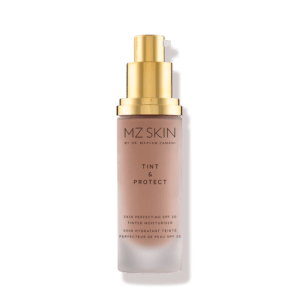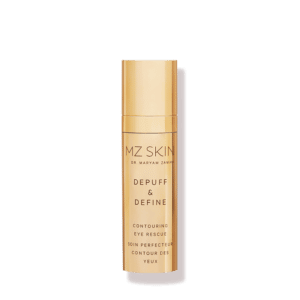Ingredient Glossary
-
1,2-Hexanediol
-
Acetyl Glycyl Beta-Alanine
A peptide that targets pigmentation and dark spots to reduce appearance.
-
Acetyl Tetrapeptide-5
A peptide that calms, soothes, hydrates and firms the skin. It is also known for reducing puffiness and swelling.
-
Adenosine Triphosphate
Topical ATP prevents early signs of premature ageing and achieves more radiant, younger-looking skin.
-
Adipic Acid/Neopentyl Glycol
Stabilises the formula and improves texture for a luxurious, silky, cushioned feel.
-
Adipic Acid/Neopentyl Glycol Crosspolymer
Stabilises the formula and improves texture for a luxurious, silky, cushioned feel.
-
Alanine
An amino acid that contains moisturising properties to hydrate skin instantly.
-
Albizia Julibrissin Bark Extract
The extract of the bark from the Falsa Mimosa contains anti-oxidant and anti-inflammatory properties.
-
Algin
A naturally occurring polymer from brown algae, that is used in skincare formulations for its emulsifying properties.
-
Allantoin
Acts as a skin protectant with soothing benefits such as, anti-inflammation and intense hydration. Suitable for sensitive skin.
-
Aloe Barbadensis Leaf Juice
The juice from Aloe Barbadensis instantly soothes inflamed skin and calms irritation.
-
Alpha-Isomethyl Ionone
Fragrance compound used to scent skincare formulations.
-
Alumina
Naturally found in rocks and soil, it is used as a thickening agent and as an absorbent.
-
Ammonium Acryloyldimethyltaurate/VP Copolymer
Used in products due to its stabilising and thickening properties. It creates a gel-like texture.
-
Anhydroxylitol
Naturally derived, it is known for its ability to retain moisture and increasing the synthesis of barrier ceramides.
-
Aqua (Water)
A solvent that allows ingredients to dissolve in the formulation and replenishes moisture in the skin.
-
Arbutin
A derivative of hydroquinone that works as a de-pigmenting agent to inhibit melanin production.
-
Arginine
An amino acid that protects from skin free-radicals, boosts collagen and increases hydration.
-
Ascophyllum Nodosum Extract
An anti-oxidant derived from black seaweed with anti-inflammatory and soothing properties.
-
Ascorbic Acid (Vitamin C)
A potent active that is clinically proven to reduce pigmentation, increase collagen production and even skin tone.
-
Ascorbyl Glucoside (Vitamin C derivative)
A water soluble derivative of Vitamin C that is clinically proven to reduce pigmentation, increase collagen production and even skin tone.
-
Ascorbyl Tetraisopalmitate (Vitamin C derivative)
A oil soluble derivative of Vitamin C that is clinically proven to reduce pigmentation, increase collagen production and even skin tone.
-
Asparagopsis Armata Extract
An extract of red algae, with soothing, anti-inflammatory and anti-oxidant properties.
-
Asparagus Officinalis Stem Extract
Naturally derived from Asparagus Officinalis that promote even skin tone and skin rejuvenation.
-
Aspartic Acid
An amino acid that hydrates the skin and boosts skin barrier repair.
-
Azelaic Acid
Gentle AHA (alpha-hydroxy acid) with anti-microbial and anti-inflammatory properties to treat blemish-prone skin and rosacea
-
Benzyl Alcohol
Benzyl Alcohol is used as a fragrance component, preservative and solvent. It has been approved for use at up to 5%.
-
Benzyl Glycol
Used as a solvent to dissolve other ingredients.
-
Benzyl Salicylate
A fragrance ingredient used to distribute scent to cosmetic products.
-
Beta-Glucan
A polysaccharide that has moisturising, soothing and anti-inflammatory properties.
-
Betaine
Helps the skin retain moisture to keep the skin hydrated for longer.
-
Butyl Methoxydibenzoylmethane
A sunscreen ingredient that works to absorb UV rays.
-
Butylene Glycol
Used in formulations to maintain the liquid consistency of products.
-
Butyrospermum Parkii (Shea) Butter
Extracted from the kernels of the fruit of the Shea tree. It has high concentration of fatty acids that promote a soft, smooth, healthy skin appearance.
-
C13-14 Isoparaffin
Isoparaffins are used as solvents in cosmetics. Animal toxicology, genotoxicity, carcinogenicity and skin sensitisation studies have concluded that isoparaffins are safe for use in cosmetics.
-
Caffeine
When applied to the skin, caffeine has soothing and anti-oxidant properties. Around the eyes, when applied caffeine can reduce the look of puffiness.
-
Calcium Aluminum Borosilicate
A mineral-derived thickening agent.
-
Calcium Gluconate
Used in cosmetics as a humectant and as a skin conditioning agent.
-
Camellia Sinensis Leaf Extract
Commonly known as the green tea extract, it has anti-oxidant and anti-inflammatory properties when used topically.
-
Caprylic/Capric Triglyceride
Derived from coconut oil, it contains fatty acids that moisturise and replenish the skin.
-
Caprylyl Glycol
An alcohol derived from a fatty acid, it is used as a skincare ingredient as a humectant, preservative and anti-inflammatory properties.
-
Carbomer
Controls the consistency of cosmetic products and is a texturising agent.
-
Caryodendron Orinocense Seed Oil (Kahai Nut Oil)
Extracted by cold-pressing the nuts of the Cacay tree. It is rich in vitamin A and has moisturising properties due to its high content in vitamin E.
-
Centella Asiatica Extract
Grown in Asia, it is regarded for its ability to repair the skins protective barrier and speed up skin cell production and collagen synthesis.
-
Cellulose Gum
A thickening and film-forming agent.
-
Ceramide 3
A lipid molecule naturally present in the skin. When used topically, it acts to improve the skin barrier function.
-
Ceratonia Siliqua (Carob) Gum
Extracted from the Carob tree. It is known for its film-forming and viscosity controlling properties.
-
Cetearyl Alcohol
Used in cosmetics to control the texture and keep formulas stable.
-
Cetyl Hydroxyethylcellulose
A modified cellulose polymer with multiple functions in formulations such as stabilising, thickening and moisturising properties.
-
Chamomilla Recutita (Matricaria) Flower Extract
An extract of camomile with soothing and anti-inflammatory properties
-
Chondrus Crispus Extract
Extract from red algae which is rich in potent anti-oxidants, amino acids and peptides that keep the skin healthy and hydrated.
-
CI 77491 (Iron Oxide Red)
A pigment used to give a pink tone.
-
CI 77492 (Iron Oxide)
A pigment used to give a yellow tone.
-
CI 77499 (Iron Oxide)
A pigment used to control the brightness of a colour within a product.
-
CI 77891 (Titanium Dioxide)
A mineral pigment that forms a UVA/ UVB filter when used as a sunscreen ingredient. It has additional properties as a pigment.
-
Citral
A component of lemongrass, orange and lemon oil.
-
Citric Acid
Found in citrus fruits such as lemon and orange, it is used to adjust the PH balance of cosmetics and also used as a preservative.
-
Citronellol
A fragrance ingredient extracted from geranium and rose plants.
-
Citrus Limon Peel Oil
An essential oil extracted from lemons used as a fragrance component.
-
Citrus Medica limonum
An extract from lemons with astringent and anti-bacterial properties.
-
Citrus Reticulata Peel Extract
Extracted from mandarin orange peel, it promotes radiance and acts as a protective agent on the skin.
-
Cocamidopropyl Betaine
A common ingredient used in cleansing products where it provides foaming and stabilising qualities.
-
Coconut Acid
It is a combination of fatty acids derived from coconut oil, it increases the foaming action and moderates the viscosity of the formula.
-
Colloidal Gold
Contains gold nano particles that is known for its anti-inflammatory and antioxidant properties
-
Darutoside
An ingredient derived from Sigesbeckia orientalis, a shrub native to India. It is known for its anti-inflammatory and anti-ageing properties.
-
Decyl Glucoside
A natural surfactant made from plant based fatty acids and glucose, used in cleansing products.
-
Dehydroacetic Acid
A preservative used in cosmetics to keep the formulas fresh, safe and stable.
-
Dextrin
A cosmetic thickener, adhesion promoter and humectant that is made from a blend of polysaccharides.
-
Dimethylaminoethanol Tartrate
Used in cosmetic formulations as a moisturizing, nourishing and firming agent.
-
Dipotassium Glycyrhizate
Ingredient derived from the licorice root. It has a myriad of uses as a soothing, anti-inflammatory and sebum regulating agent.
-
Dipropylene Glycol
An ingredient that enhances the texture and stability of cosmetic formulations.
-
Disodium EDTA
Disodium EDTA functions as a chelating agent to stabilise formulations and boost preservative efficacy. Toxicology studies have found it to be safe to consumers in cosmetic formulations and it is approved by both the EU and FDA.
-
Ethyl Ascorbic Acid
A derivative of vitamin C that is stable and soluble in both water and oil.
-
Ethyl Macadamiate
Derived from macadamia nut oil, it is a natural alternative to silicones that has skin softening properties due to the high content of essential fatty acids.
-
Ethylhexyl Methoxycinnamate
A sunscreen ingredient that protects the skin from UVB rays.
-
Ethylhexyl Salicylate
A sunscreen ingredient that protects the skin from UVB rays.
-
Ethylhexylglycerin
A preservative used in cosmetics to keep formulas stable and fresh.
-
French Red Clay
Rich in minerals, French red clay gently cleanses and exfoliates the skin.
-
Geraniol
Fragrance ingredient derived from rose, geranium and citronella plants.
-
Gluconate
Classified as a pH regulator, humectant and anti-discoloration agent.
-
Gluconolactone
Polyhydroxy acid (PHA) that gently exfoliates the skin and has long-term anti-ageing benefits through increasing cell turnover.
-
Glucose
A simple sugar that is used in cosmetics as a humectant.
-
Glycerin
A common ingredient used in cosmetics as a humectant to prevent water loss, as a viscosity decreasing agent and as a skin protectant.
-
Glyceryl Caprylate
Derived from coconuts, it is a highly versatile ingredient as it can be used an emulsifier, preservative booster and moisturizing agent.
-
Glyceryl Dibehenate
Used in cosmetic formulations as an emulsifying agent.
-
Glyceryl Linoleate
Used in cosmetic formulations as an emulsifying agent.
-
Glycine
An amino acid with anti-ageing and anti-redness properties,
-
Glycine Soja (Soybean) Oil
Derived from soy beans, this rich oil is known for its anti-ageing and skin conditioning properties.
-
Glycine Soja (Soybean) Phytoplacenta Extract
Derived from soy beans, this ingredient is rich in proteins and amino acids that work to calm and soothe the skin.
-
Glycolic Acid
An AHA acid that exfoliates the outermost layer of skin cells and targets a myriad of concerns such as breakouts, hyperpigmentation, dullness, and signs of skin ageing.
-
Glycyrrhiza Glabra (Licorice) Root Extract
Ingredient derived from the licorice root. It has a myriad of uses as a soothing, anti-inflammatory and sebum regulating agent.
-
Glycyrrhiza Uralensis Extract
Ingredient derived from the licorice root. It has a myriad of uses as a soothing, anti-inflammatory and sebum regulating agent.
-
Gossypium Herbaceum (Cotton) Extract
Derived from cotton seed oil, this ingredient is a soothing and skin conditioning.
-
Hexyl Cinnamal
Fragrance ingredient that has jasmine like notes.
-
Histidine
An amino acid with antioxidant and anti-ageing benefits
-
Hordeum Vulgare Seed Extract
Naturally derived from Barley, this extract has detoxifying and anti-inflammatory properties.
-
Hyaluronic Acid
Hyaluronic acid immediately hydrates and plumps the skin by binding water to collagen, thus trapping moisture in the skin.
-
Hydrolyzed Collagen
This ingredient is a mixture of collagen chains, that increase moisture levels in the skin by trapping water molecules.
-
Hydrolyzed Glycosaminoglycans
This ingredient is a mixture of polysaccharides that work to moisturise and soften the skin.
-
Hydrolysed Hyaluronic Acid
Lower molecular-weight hyaluronic acid, penetrates deeper to for plumping and filling benefits.
-
Hydrolyzed Pea Protein
A mixture of peptide chain with skin conditioning and emollient properties.
-
Hydrolyzed Vegetable Protein
A mixture of plant based peptide chains with skin conditioning and emollient properties.
-
Hydrolyzed Yeast Extract
Plant based extract that can stimulate the synthesis of hyaluronic acid and thereby moisturise the skin.
-
Hydroxyacetophenone
This ingredient has the ability to boost preservative function in formulations and fight against free radicals due to its antioxidant properties.
-
Isoamyl Laurate
A fatty acid ester that is used to enhance the texture of formulations.
-
Isoleucine
An amino acid with moisturising and barrier repairing properties.
-
Isononyl Isononanoate
Used to improve the texture and feel of formulations.
-
Isopropyl Myristate
An emollient ingredient that increases moisture levels in the skin. It also enhances the penetration of active ingredients.
-
Isopropyl Titanium Triisostearate
Emulsifier with emollient properties.
-
Isostearic Acid
A fatty acid that is used as a binder and to thicken formulas.
-
Lactic Acid
A AHA (alpha hydroxy acid) that provides gentle exfoliation to brighten dull skin and reduce the appearance of wrinkles.
-
Lactobionic Acid
A PHA (poly hydroxy acid), that gently exfoliates and smoothes the skin.
-
Laureth-7
Derived from coconut oil, it is used as a cleansing agent and texture enhancer.
-
Lecithin
Consisting mainly of phospholipids, it is a skin conditioning and moisturising agent.
-
Limonene
A fragrance ingredient that is the main constituent of citrus peel oil.
-
Linalool
Fragrance ingredient derived from lavender.
-
Lolium Perenne Flower Extract
Extract of the ryegrass plant with anti-ageing and anti-oxidant properties.
-
Malic Acid
A AHA( alpha hydroxy acid) that provides chemical exfoliation and boosts cell turnover to brighten the skin.
-
Maltodextrin
Derived from rice and potato starch, it is a mattifying agent that also helps to stabilise formulations.
-
Marrubium Vulgare Meristem Cell Culture
Plant stem cell extract that protects against environmental stressors.
-
Mentha Piperita (Peppermint) Oil
Derived from peppermint, this oil is known for its refreshing scent and anti-inflammatory properties.
-
Menthyl Lactate
This ingredient is used for its cooling and refreshing properties.
-
Methylsilanol Mannuronate
An anti-ageing and anti-oxidant agent that is well suited for sensitive skin.
-
Mica
Mineral derived ingredient that is used in products to add shimmer and shine.
-
Myristoyl Tripeptide-31
A peptide that can have a retinol-like effect on the skin, to improve texture and tone.
-
Myristyl Myristate
Used in formulations as a texture enhancer and emollient.
-
Niacinamide
Also known as Vitamin B3, it is highly regarded for its ability to minimise pores, prevent breakouts and hydrate the skin.
-
o-Cymen-5-ol
Preservative widely used in cosmetics. It is effective against fungal and bacterial growth which is needed to keep cosmetics safe for consumers.
. -
Olive Glycerides
Lipid derived from olive oil that has hydrating and moisture replenishing properties.
-
Paeonia Suffruticosa Root Extract
A plant based extract that is a natural antioxidant and can be used to boost microcirculation.
-
Panthenol
Also known as Vitamin B5, this is a widely studied ingredient with proven moisturising properties.
-
Papain
Gentle peeling agent derived from plants that decreases inflammation and boosts cell renewal.
-
Parfum (Fragrance)
Fragrance ingredient.
-
PCA
PCA (pyrrolidone carboxylic acid), derived from amino acids, serves as a humectant in cosmetic formulations.
-
PEG-40 Hydrogenated Castor Oil
Polyethylene glycols (PEGs) are used in cosmetic formulations as surfactants, emulsifiers and skin conditioners. Toxicology studies have concluded that PEGs are not associated with skin irritation or adverse systemic effects.
-
Pentylene Glycol
Both water and oil-soluble, this ingredient has moisture-binding and anti-microbial properties.
-
Phenoxyethanol
Phenoxyethanol is one of the most widely used preservatives in cosmetics as it has a large spectrum of antimicrobial activity and is effective against gram-negative and gram-positive bacteria, as well as yeasts. Phenoxyethanol is safe for consumers and is necessary to keep formulations free of any microbial activity.



















